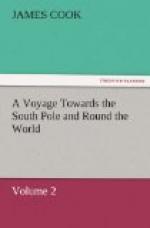The wind was very variable till noon, when it fixed at N.N.E., and blew a gentle gale; but it increased in such a manner, that, before three o’clock, we were reduced to our two courses, and obliged to strike top-gallant yards. We were very fortunate in getting clear of the land, before this gale overtook us; it being hard to say what might have been the consequence had it come on while we were on the north coast. This storm was of short duration; for, at eight o’clock it began to abate; and at midnight it was little wind. We then took the opportunity to sound, but found no bottom with a line of an hundred and eighty fathoms.
Next day the storm was succeeded by a thick fog, attended with rain; the wind veered to N.W., and, at five in the morning, it fell calm, which continued till eight; and then we got a breeze southerly, with which we stood to the east till three in the afternoon. The weather then coming somewhat clear, we made sail, and steered north in search of land; but, at half-past six, we were again involved in a thick mist, which made it necessary to haul the wind, and spend the night in making short boards.
We had variable light airs next to a calm, and thick foggy weather, till half-past seven o’clock in the evening of the 22d, when we got a fine breeze at north, and the weather was so clear that we could see two or three leagues round us. We seized the opportunity, and steered to west; judging we were to the east of the land. After running ten miles to the west, the weather again became foggy, and we hauled the wind, and spent the night under top-sails.
Next morning at six o’clock, the fog clearing away, so that we could see three or four miles, I took the opportunity to steer again to the west, with the wind at east, a fresh breeze; but two hours after, a thick fog once more obliged us to haul the wind to the south. At eleven o’clock, a short interval of clear weather gave us view of three or four rocky islets extending from S.E. to E.N.E., two or three miles distant; but we did not see the Sugar-Loaf Peak beforementioned. Indeed, two or three miles was the extent of our horizon.
We were well assured that this was the land we had seen before, which we had now been quite round; and therefore it could be no more than a few detached rocks, receptacles for birds, of which we now saw vast numbers, especially shags, who gave us notice of the vicinity of land before we saw it. These rocks lie in the latitude of 55 deg. S., and S. 75 deg. E., distant twelve leagues from Cooper’s Isle.
The interval of clear weather was of very short duration, before we had as thick a fog as ever, attended with rain, on which we tacked in sixty fathoms water, and stood to the north. Thus we spent our time, involved in a continual thick mist; and, for aught we knew, surrounded by dangerous rocks. The shags and soundings were our best pilots; for after we had stood a few miles to the north, we got out of soundings,




